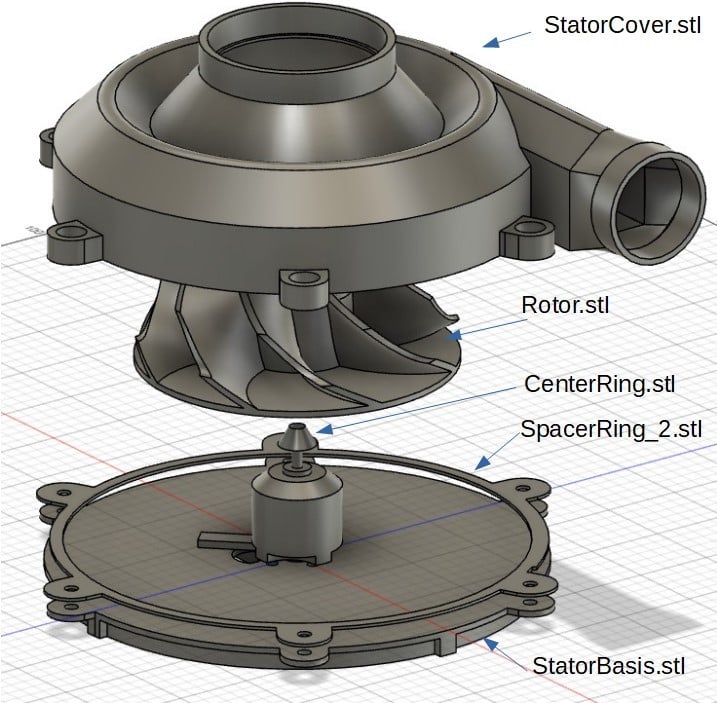
Turbine Fan
thingiverse
I designed this turbine fan to collect wood flour from my CNC machine. It is driven from **A2212 BLDC outrunner motor** (1800KV). In addition, an **ESC** and something that generates the speed request are required. In my case a China-**Ardunio Micro Pro**. For a sufficient throughput its needs a power consumption of 15 W at a supply voltage of 7.5 V. Except for the spacer ring, all parts are printed with ABS for stability and the possibility of stable gluing. The spacer ring is made of TPU. For adjusting the air gap between rotor and stator, the space rings are 1 or 2 mm high and can be combined. The rotor should be **counterbalanced** before long-term use. I needed 0.6 g of mass, which I glued to the rotor take from a copper wire. I use the turbine together with a [cyclone](https://www.thingiverse.com/thing:6189487) and a [milling head adapter](https://www.thingiverse.com/thing:6189462). The noise level of the turbine is significantly higher than that of the CNC machine: 73 dB at 1m, 54 dB in an enclosure with 6 mm plexiglass. 38 dB with enclosure in the neighboring room The **flow rate** on the pressure side at ambient pressure is approx: @12V & 2 A: 4.5 l/s = 16 m<sup>3</sup>/h = 9.5 cfm @12V & 6 A: 14 l/s = 50 m<sup>3</sup>/h = 30 cfm The measurement was made by inflating a 100 l rubbish bag, which took 21 and 7 s. When I receive the ordered wind speed meter, I will cross-check the values. Calculations using pressure difference and opening area yielded values that were far too small. Maybe the formulas in https://de.wikipedia.org/wiki/D%C3%BCsenstr%C3%B6mung do not apply to such pressure differences and opening areas. With a 2 mm spacer ring, the **max. suction pressure** is: @12V & 2 A: 8.4 Pa @12V & 6 A: 18.2 Pa --------------------------- Diesen Turbinenventilator habe ich entworfen, um Holzmehl von einer CNC-Maschine abzusaugen. Er wird von einen **A2212 BLDC-Aussenläufer-Motor** (1800KV) angetrieben. Zusätzlich braucht man noch einen **ESC** und irgendetwas, das den Drehzahlsollwert erzeugt. In meinem Fall ein **Ardunio Micro Pro** aus China. Eine Leistungsaufnahme von 15 W bei 7,5 V Versorgungsspannung reicht aus, um eine ausreichende Saugleistung zu erzielen. Wegen Stabilität und der Möglichkeit einer stabilen Verleimung sind außer dem Dichtring alle Teile mit ABS gedruckt. Der Dichtring besteht aus TPU. Der Rotor sollte vor einer dauerhaften Verwendung unbedingt ausgewuchtet werden. Ich benötigte 0,6 g Masse, welche ich als Cu-Draht auf dem Rotor klebte. Die Turbine verwende ich zusammen mit einem [Zyklon](https://www.thingiverse.com/thing:6189487) und einem [Fräskopfadapter](https://www.thingiverse.com/thing:6189462). Der Geräuschpegel der Turbine liegt deutlich über dem der CNC-Maschine: 73 dB in 1m Entfernung, 54 dB in einer Einhausung mit 6 mm Plexiglas. 38 dB mit Einhausung im Nachbarzimmer Der **Volumenstrom** auf der Druckseite bei Umgebungsdruck ist ungefähr: @12V & 2 A: 4,5 l/s = 16 m<sup>3</sup>/h = 9,5 cfm @12V & 6 A: 14 l/s = 50 m<sup>3</sup>/h = 30 cfm Die Messung erfolgte durch aufblasen eines 100 l Müllbeutels, was 21 und 7 s dauerte. Wenn ich den bestellten Windgeschwindigkeitsmesser erhalte, werde ich die Werte gegenprüfen . Berechnungen mittels Druckdifferenz und Öffnungsfläche lieferten viel zu kleine Werte. Vielleicht gelten die Formeln in https://de.wikipedia.org/wiki/D%C3%BCsenstr%C3%B6mung nicht für solche Druckdifferenzen und Öffnungsflächen. Mit einem 2 mm Abstandsring beträgt der **max. Saugdruck**: @12V & 2 A: 8,4 Pa @12V & 6 A: 18,2 Pa
With this file you will be able to print Turbine Fan with your 3D printer. Click on the button and save the file on your computer to work, edit or customize your design. You can also find more 3D designs for printers on Turbine Fan.
